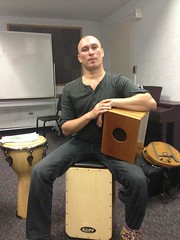![]()
![]()
![]()
Use LEFT and RIGHT arrow keys to navigate between flashcards;
Use UP and DOWN arrow keys to flip the card;
H to show hint;
A reads text to speech;
19 Cards in this Set
- Front
- Back
|
Andalusia |
refers to the area of southern Spain and southwestFrance that was ruled for nearly eight centuries by Arab and Berber Muslims, who werereferred to collectively as Moors in Andalusia was the site of wealth and learning during Europe’s Dark AgesEurope |
|
|
Roma |
Gypsies of West spain |
|
|
Romani |
Philologists uncovered the Indicroots of their language |
|
|
Gitano |
an underclass identity (Manual 1989:49).The Roma, who became known as Gitanoin Andalusía, were victimized until CharlesIII decreed an end to the official persecutionin 1782, though severe discriminationpersisted |
|
|
Calo |
Gitano dialect of Spanish consisting of Spanish with Gitano pronunciations and someborrowed Romani words. |
|
|
Juergas |
Gatherings where flamenco is performed are called |
|
|
jaleo |
exclamations of vocal encouragement |
|
|
palmas |
Clapping |
|
|
Cante |
(song) |
|
|
Baile |
dance |
|
|
toque |
Music- Guitar music |
|
|
cantaor |
The texts or coplas of flamenco song are usually written by thecantaor (singer, masculine, cantaora feminine) |
|
|
Duende |
Duende is often translated as “ecstasy,” though watching awrenching flamenco performance one can see that this is a different kind of ecstasy thanin the Arab world, perhaps a more cathartic one, releasing tension or tortured sorrow,lamenting fate, or reveling in passion. That duende literally means “demon” or “spirit” alsosuggests entrancement or a possessed quality, though Totton (2003:59) points out thatsuch performative power requires tremendous technique, artistry, and control, not simplywildness and passion. |
|
|
soleares |
Type of flammenco music |
|
|
Camarón de la Isla |
Camarón de la Isla, known simple as“Camarón,” was the greatest flamenco singer of the late 20th century. His tortured voicecombined with deep artistry seemed to evoke the depths of Gitano ethos, evoking whatsome called “a fracture of the soul” (Fairley 1994:138) |
|
|
Paco de Lucia |
unquestioned master of flamenco guitar, but he was also a payo—of non-Gitano descent.A virtuoso, de Lucía helped expand the harmonic range of flamenco music with jazzharmonies and lengthy musical arrangements. He launched a career as a solo artist andleader of a primarily instrumental group, and he even collaborated with jazz artists, suchas pianist Chick Corea, and guitarists John McClaughlin and Al Dimiola |
|
|
cajón |

Afro-Peruvian cajón drum |
|
|
nuevo flamenco |
xpanded the traditionalflamenco with new instruments, song forms, and arrangements. Fretless bass guitar wasintroduced to the flamenco ensemble, as was the Afro-Peruvian cajón drum Mid 20th century |
|
|
Ojos de Brujo |
Ojos de Brujo have even worked in electronics, funkbackbeats, and turntables (sampling and scratching classic flamenco records, no less)into their music, which they have dubbed “jip jop [hip-hop] flamenkillo.” |

